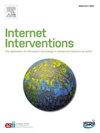Efficacy of a brief online intervention in reducing excessive worry and improving daily functioning: A randomized trial with mediation analysis
IF 4.1
2区 医学
Q1 HEALTH CARE SCIENCES & SERVICES
Internet Interventions-The Application of Information Technology in Mental and Behavioural Health
Pub Date : 2025-06-10
DOI:10.1016/j.invent.2025.100842
引用次数: 0
Abstract
Excessive worry is common among treatment-seeking individuals in primary care and has a negative impact on daily functioning, which may also lead to other mental health problems. The current study tested whether a worry-focused online intervention – provided in both a guided and an unguided format – was efficacious in reducing worry-related symptoms and if these effects were specifically linked to improvements in daily functioning. A total of 82 participants were randomized to intervention with therapist support (guided; n = 28), intervention without therapist support (unguided; n = 27) or to waiting list (n = 27). Results showed that the online intervention was more effective than waiting list in reducing worry at week 5 (between-group d = 0.96). The intervention was effective against waiting list irrespective of whether it was provided in a guided (between-group d = 0.90) or unguided format (between-group d = 1.07) with sustained results at the 7-week follow-up. Reduction in worry mediated improvement in daily functioning (between-group d = 0.58; indirect effect estimate = −1.06 [95 % CI: −1.76 to −0.51], 66 % mediated effect). The mediation effects were fairly robust to mediator-outcome confounding, with residual correlation values set to r = 0.3 in a sensitivity analysis. The results provide further evidence that it is beneficial to provide a low-threshold, easy access intervention to patients with excessive worry, irrespective of primary diagnosis. Clinical implications are discussed.
简短的在线干预在减少过度忧虑和改善日常功能方面的效果:一项随机试验与中介分析
过度担忧在寻求初级保健治疗的个人中很常见,对日常功能有负面影响,这也可能导致其他心理健康问题。目前的研究测试了以焦虑为中心的在线干预——以指导和非指导的形式提供——是否对减少焦虑相关症状有效,以及这些效果是否与日常功能的改善特别相关。共有82名参与者被随机分配到治疗师支持的干预组(引导;N = 28),无治疗师支持的干预(无指导;N = 27)或等候名单(N = 27)。结果显示,在线干预在减少第5周焦虑方面比等候名单更有效(组间d = 0.96)。在7周的随访中,无论以引导(组间d = 0.90)还是非引导(组间d = 1.07)的形式提供干预措施,对等候名单都是有效的。忧虑介导的日常功能改善减少(组间d = 0.58;间接效应估计= - 1.06 [95% CI: - 1.76至- 0.51],66%介导效应)。中介效应对中介-结局混淆相当稳健,在敏感性分析中残差相关值设为r = 0.3。结果进一步证明,对过度焦虑的患者提供低门槛、容易获得的干预是有益的,无论其最初诊断如何。讨论了临床意义。
本文章由计算机程序翻译,如有差异,请以英文原文为准。
求助全文
约1分钟内获得全文
求助全文
来源期刊

Internet Interventions-The Application of Information Technology in Mental and Behavioural Health
Medicine-Health Informatics
CiteScore
6.50
自引率
9.30%
发文量
94
审稿时长
6 weeks
期刊介绍:
Official Journal of the European Society for Research on Internet Interventions (ESRII) and the International Society for Research on Internet Interventions (ISRII).
The aim of Internet Interventions is to publish scientific, peer-reviewed, high-impact research on Internet interventions and related areas.
Internet Interventions welcomes papers on the following subjects:
• Intervention studies targeting the promotion of mental health and featuring the Internet and/or technologies using the Internet as an underlying technology, e.g. computers, smartphone devices, tablets, sensors
• Implementation and dissemination of Internet interventions
• Integration of Internet interventions into existing systems of care
• Descriptions of development and deployment infrastructures
• Internet intervention methodology and theory papers
• Internet-based epidemiology
• Descriptions of new Internet-based technologies and experiments with clinical applications
• Economics of internet interventions (cost-effectiveness)
• Health care policy and Internet interventions
• The role of culture in Internet intervention
• Internet psychometrics
• Ethical issues pertaining to Internet interventions and measurements
• Human-computer interaction and usability research with clinical implications
• Systematic reviews and meta-analysis on Internet interventions
 求助内容:
求助内容: 应助结果提醒方式:
应助结果提醒方式:


